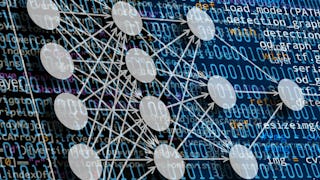Gain hands-on experience in deep learning with Python and learn to design, train, and optimize advanced neural networks for real-world artificial intelligence applications. This course is ideal for data scientists, machine learning engineers, and AI enthusiasts who want to enhance their skills in building intelligent systems using Python.


您将学到什么
Understand the core components of deep learning models and their role in AI.
Apply CNN, R-CNN, and Faster R-CNN for object detection tasks.
Implement RNNs and LSTMs for sequential data processing.
Optimize and evaluate deep learning models for improved performance.
要了解的详细信息

添加到您的领英档案
13 项作业
了解顶级公司的员工如何掌握热门技能

积累特定领域的专业知识
- 向行业专家学习新概念
- 获得对主题或工具的基础理解
- 通过实践项目培养工作相关技能
- 获得可共享的职业证书

该课程共有4个模块
In this module, you will explore the fundamental components of deep learning by designing perceptron and implementing their functionality. You will address the limitations of perceptron by utilizing Multi-Layer Perceptron (MLPs) and observe how MLPs significantly enhance model performance.
涵盖的内容
25个视频4篇阅读材料4个作业2个讨论话题1个插件
In the second module of this course, learners will learn about the working of Convolutional Neural Networks (CNN) and understand their importance in training deep learning models. Learners will also work on improving CNN model performance using RCNN and Faster RCNN, observe the computation time of these models, and gauge their accuracy score.
涵盖的内容
27个视频3篇阅读材料4个作业1个讨论话题
This module focuses on Recurrent Neural Networks (RNNs) and Long Short-Term Memory (LSTM) networks for sequential data processing. Learners will gain practical skills in building, training, and optimizing models for complex tasks.
涵盖的内容
24个视频4篇阅读材料4个作业
This module is designed to assess an individual on the various concepts and teachings covered in this course. Evaluate your knowledge with a comprehensive graded quiz on SLP, MLP, RNN, CNN, LSTM and many more complex deep learning concepts.
涵盖的内容
1个视频1篇阅读材料1个作业1个讨论话题1个插件
获得职业证书
将此证书添加到您的 LinkedIn 个人资料、简历或履历中。在社交媒体和绩效考核中分享。
从 Machine Learning 浏览更多内容
 状态:免费试用
状态:免费试用 状态:免费试用
状态:免费试用 状态:免费试用
状态:免费试用 状态:免费试用状态:人工智能技能
状态:免费试用状态:人工智能技能
人们为什么选择 Coursera 来帮助自己实现职业发展




常见问题
Deep learning is a subset of machine learning that emphasizes artificial neural network algorithms designed to mimic the structure and functions of the human brain. Multi-layered neural networks are developed to autonomously learn and identify features from vast datasets, enabling them to effectively perform tasks such as speech recognition, image recognition, and natural language processing. Deep learning plays a crucial role in AI advancements as it requires extensive amounts of data and computational strength.
The target audience for Practical Deep Learning with Python comprises beginners and intermediate learners eager to grasp and utilize deep learning methods with Python. This course is tailored for for data scientists, AI Research Analysts, and developers who possess fundamental programming skills and a basic grasp of machine learning principles.
To effectively follow the exercises and examples in Practical Deep Learning with Python, you will need a computer with the following minimum system requirements:
- Operating System: Windows, macOS, or Linux.
- Processor: A multi-core processor (preferably with support for AVX instructions).
- RAM: At least 8 GB of RAM, though 16 GB or more is recommended for larger datasets.
- Storage: At least 10 GB of free disk space to accommodate datasets, libraries, and project files.
- Python Environment: Python 3.6 or later installed with libraries such as TensorFlow or PyTorch, NumPy, Matplotlib, and Pandas.
Please note: All the practical are performed on Google Colab
更多问题
提供助学金,


 中
中

